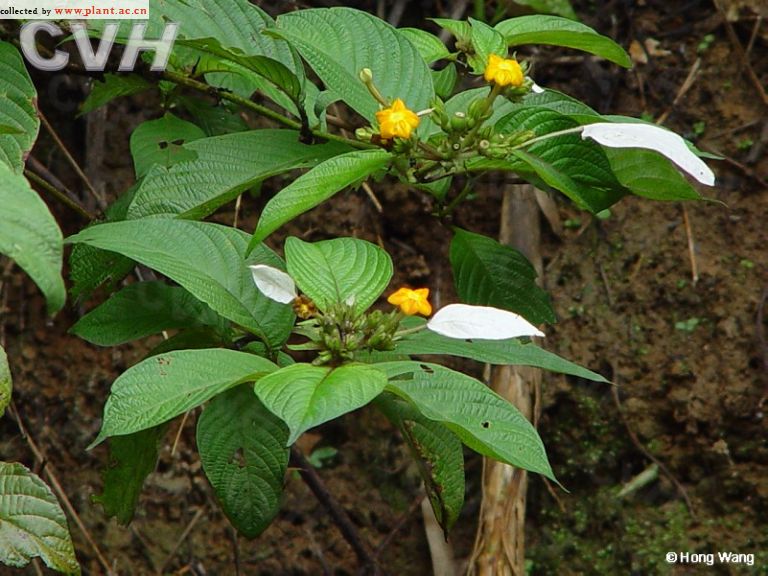大叶玉叶金花Mussaenda macrophylla Wall.
大叶玉叶金花Mussaenda macrophylla Wall.
3. 大叶玉叶金花(台湾植物志)图版77:1-4
Mussaenda macrophylla Wall. in Roxb. Fl. Ind. ed. Carey 2: 228. 1824; Hook. f. Fl. Brit. Ind. 3: 89. 1880; Matsum. in Bot. Mag. Tokyo 14: 147. 1900; King et Gamble, Mat. Fl. Malay Penins. 14: 73. 1904; Matsum. et Hayata in Journ. Coll. Sci. Tokyo 22: 188. 1906; Hutchins. in Sargent, Pl. Wils. 3: 396. 1916; Li, Woody Fl. Taiwan 862. 1963; J. M. Chao in Li, Fl. Taiwan 4: 310. 1978; 云南种子植物名录, 下册: 1263. 1984. ——M. hispida D. Don, Prodr. Fl. Nepal. 139. 1825.——M. kotoensis Hayata in Journ. Coll. Sci. Tokyo 30 (1): 143. 1911 et Ic. Pl. Formos. 2: 93, t. 4. 1911; Kanehira, Formos. Trees rev. ed. 674. f. 626. 1936.
直立或攀援状灌木;老枝四棱柱形,棕褐色,小枝近圆柱形,密被灰棕色长柔毛。叶对生,长圆形至卵形,长12-14厘米,宽8-9厘米,顶端短尖,基部楔形,两面被疏散贴伏柔毛,脉上毛更密;叶柄极短或近无柄;托叶大,卵形,短尖,长约1厘米,2浅裂,密被棕色柔毛。聚伞花序有短总花梗;苞片大,长约1厘米,2-3深裂,裂片披针形,渐尖,密被长柔毛;花大,橙黄色,近无柄;花萼管钟形,长3毫米,密被棕色柔毛,萼裂片近叶状,披针形,密被棕色柔毛,长1-1.5厘米;花叶宽卵形或菱形,渐尖,薄膜质,白色,长5-12厘米,有纵脉7条,柄长3.7厘米,略被长柔毛;花冠管淡绿色,长1.7厘米,中部以上略膨大,密被柔毛,花冠裂片卵形,长7毫米,渐尖,有硬尖头,外面疏被长柔毛,内面有稠密黄色疣突,喉部有稠密淡黄色棒状毛;雄蕊内藏;花柱内藏,柱头2,线形。浆果深紫色,椭圆状,长1-1.5厘米,被短柔毛。花期6-7月,果期8-11月。
产于台湾、广东、广西和云南;生于海拔达1300米处的山地灌丛中或森林中。国外分布于印度东北部、尼泊尔、马来半岛、菲律宾和印度尼西亚(爪哇)。
《Flora of China》 Vol. 19 (2011)
Mussaenda macrophylla Wallich in Roxburgh Fl. Ind. 2: 228. 1824.
大叶玉叶金花 da ye yu ye jin hua
Mussaenda hispida D. Don; M. kotoensis Hayata.
Erect or climbing shrubs; branches terete to quadrangular, sparsely to moderately sericeous. Leaves opposite; petiole 4-35 mm, sparsely hirsute to glabrescent; blade drying membranous to papery, green to brownish, paler below when specimen well preserved, elliptic-oblong, elliptic, or ovate, 12-21 × 8-11 cm, both surfaces sparsely strigillose to pilose on lamina and moderately hirsute along principal veins, base cuneate to obtuse, apex acute to acuminate; secondary veins 6-8 pairs, without domatia, tertiary venation reticulate; stipules deciduous, ovate to triangular, 5-8 mm, sparsely brown hirsute to glabrescent, deeply 2-lobed, lobes acute to acuminate. Inflorescences laxly cymose, 6-15 cm, hirsute, sessile with arching lateral axes; bracts lanceolate or 2- or 3-parted, 5-10 mm, obtuse to acuminate. Flowers subsessile, biology not noted. Calyx with hypanthium portion campanulate to obconic, 3-4 mm, densely brown strigose to sericeous; lobes lanceolate, ligulate, or oblanceolate, 4-11 × 1.5-3 mm, often unequal on an individual flower, densely to moderately strigillose to strigose, acute, with 1 lobe on 1 to several flowers in each inflorescence expanded into white calycophyll, blade broadly ovate or rhombic, 5-12 cm, both surfaces sparsely hirsute to glabrescent on lamina and moderately to densely pilosulous to puberulent on principal veins, base obtuse to truncate, stipe 18-37 mm, apex obtuse to shortly acuminate. Corolla orange-yellow to golden yellow, salverform, outside densely sericeous; tube 20-25 mm; lobes ovate, 7-10 mm, acute to acuminate. Berry ellipsoid, 10-15 mm, strigose, lenticellate, calyx limb deciduous. Fl. Jun-Jul, fr. Aug-Nov.
Thickets or forests on mountains; sea level to 1300 m. Guangdong, Guangxi, Taiwan [Indonesia, Malaysia, Philippines].
This species is circumscribed somewhat differently here than by H. H. Hsue and H. Wu (in FRPS 71(1): 287-289. 1999); see comments under Mussaenda treutleri.This species is circumscribed somewhat differently here than by H. H. Hsue and H. Wu (in FRPS 71(1): 287-289. 1999); see comments under Mussaenda treutleri.
别名:大叶玉金花;野马野合;
科名:茜草科 Rubiaceae
属名:玉叶金花属 Mussaenda

3. 大叶玉叶金花(台湾植物志)图版77:1-4
Mussaenda macrophylla Wall. in Roxb. Fl. Ind. ed. Carey 2: 228. 1824; Hook. f. Fl. Brit. Ind. 3: 89. 1880; Matsum. in Bot. Mag. Tokyo 14: 147. 1900; King et Gamble, Mat. Fl. Malay Penins. 14: 73. 1904; Matsum. et Hayata in Journ. Coll. Sci. Tokyo 22: 188. 1906; Hutchins. in Sargent, Pl. Wils. 3: 396. 1916; Li, Woody Fl. Taiwan 862. 1963; J. M. Chao in Li, Fl. Taiwan 4: 310. 1978; 云南种子植物名录, 下册: 1263. 1984. ——M. hispida D. Don, Prodr. Fl. Nepal. 139. 1825.——M. kotoensis Hayata in Journ. Coll. Sci. Tokyo 30 (1): 143. 1911 et Ic. Pl. Formos. 2: 93, t. 4. 1911; Kanehira, Formos. Trees rev. ed. 674. f. 626. 1936.
直立或攀援状灌木;老枝四棱柱形,棕褐色,小枝近圆柱形,密被灰棕色长柔毛。叶对生,长圆形至卵形,长12-14厘米,宽8-9厘米,顶端短尖,基部楔形,两面被疏散贴伏柔毛,脉上毛更密;叶柄极短或近无柄;托叶大,卵形,短尖,长约1厘米,2浅裂,密被棕色柔毛。聚伞花序有短总花梗;苞片大,长约1厘米,2-3深裂,裂片披针形,渐尖,密被长柔毛;花大,橙黄色,近无柄;花萼管钟形,长3毫米,密被棕色柔毛,萼裂片近叶状,披针形,密被棕色柔毛,长1-1.5厘米;花叶宽卵形或菱形,渐尖,薄膜质,白色,长5-12厘米,有纵脉7条,柄长3.7厘米,略被长柔毛;花冠管淡绿色,长1.7厘米,中部以上略膨大,密被柔毛,花冠裂片卵形,长7毫米,渐尖,有硬尖头,外面疏被长柔毛,内面有稠密黄色疣突,喉部有稠密淡黄色棒状毛;雄蕊内藏;花柱内藏,柱头2,线形。浆果深紫色,椭圆状,长1-1.5厘米,被短柔毛。花期6-7月,果期8-11月。
产于台湾、广东、广西和云南;生于海拔达1300米处的山地灌丛中或森林中。国外分布于印度东北部、尼泊尔、马来半岛、菲律宾和印度尼西亚(爪哇)。
《Flora of China》 Vol. 19 (2011)
Mussaenda macrophylla Wallich in Roxburgh Fl. Ind. 2: 228. 1824.
大叶玉叶金花 da ye yu ye jin hua
Mussaenda hispida D. Don; M. kotoensis Hayata.
Erect or climbing shrubs; branches terete to quadrangular, sparsely to moderately sericeous. Leaves opposite; petiole 4-35 mm, sparsely hirsute to glabrescent; blade drying membranous to papery, green to brownish, paler below when specimen well preserved, elliptic-oblong, elliptic, or ovate, 12-21 × 8-11 cm, both surfaces sparsely strigillose to pilose on lamina and moderately hirsute along principal veins, base cuneate to obtuse, apex acute to acuminate; secondary veins 6-8 pairs, without domatia, tertiary venation reticulate; stipules deciduous, ovate to triangular, 5-8 mm, sparsely brown hirsute to glabrescent, deeply 2-lobed, lobes acute to acuminate. Inflorescences laxly cymose, 6-15 cm, hirsute, sessile with arching lateral axes; bracts lanceolate or 2- or 3-parted, 5-10 mm, obtuse to acuminate. Flowers subsessile, biology not noted. Calyx with hypanthium portion campanulate to obconic, 3-4 mm, densely brown strigose to sericeous; lobes lanceolate, ligulate, or oblanceolate, 4-11 × 1.5-3 mm, often unequal on an individual flower, densely to moderately strigillose to strigose, acute, with 1 lobe on 1 to several flowers in each inflorescence expanded into white calycophyll, blade broadly ovate or rhombic, 5-12 cm, both surfaces sparsely hirsute to glabrescent on lamina and moderately to densely pilosulous to puberulent on principal veins, base obtuse to truncate, stipe 18-37 mm, apex obtuse to shortly acuminate. Corolla orange-yellow to golden yellow, salverform, outside densely sericeous; tube 20-25 mm; lobes ovate, 7-10 mm, acute to acuminate. Berry ellipsoid, 10-15 mm, strigose, lenticellate, calyx limb deciduous. Fl. Jun-Jul, fr. Aug-Nov.
Thickets or forests on mountains; sea level to 1300 m. Guangdong, Guangxi, Taiwan [Indonesia, Malaysia, Philippines].
This species is circumscribed somewhat differently here than by H. H. Hsue and H. Wu (in FRPS 71(1): 287-289. 1999); see comments under Mussaenda treutleri.This species is circumscribed somewhat differently here than by H. H. Hsue and H. Wu (in FRPS 71(1): 287-289. 1999); see comments under Mussaenda treutleri.

